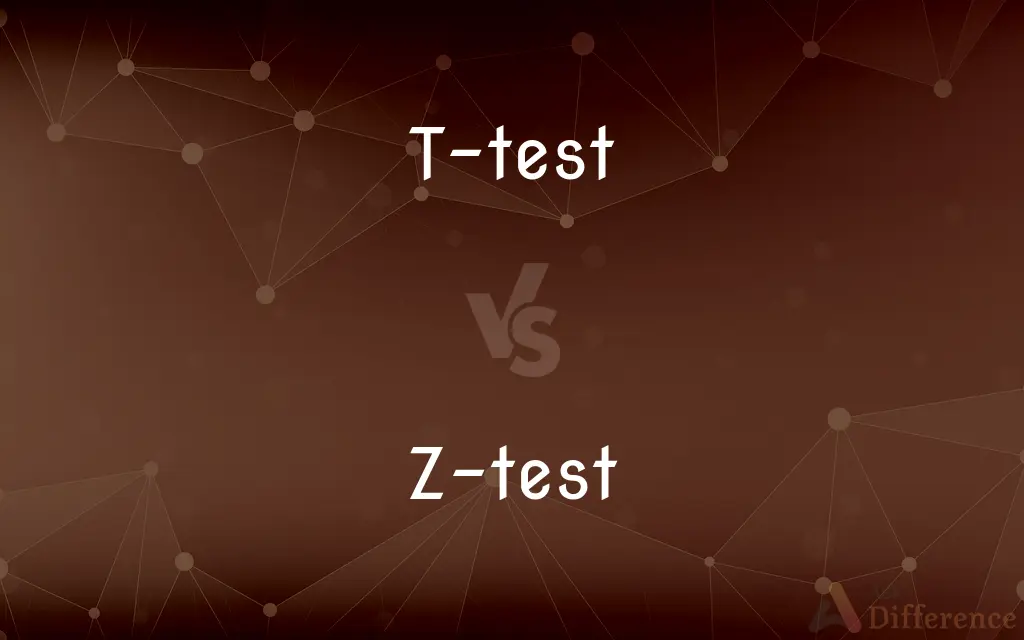T-Test vs. Z-Test — What's the Difference?
By Tayyaba Rehman — Published on December 15, 2023
T-Test is used for comparing means in small samples or unknown variances; Z-Test is for large samples with known variances.

Difference Between T-Test and Z-Test
Table of Contents
ADVERTISEMENT
Key Differences
The T-Test is a statistical test primarily used when the data sets are small or when the population variance is unknown. On the other hand, the Z-Test is employed when the data sets are larger and the population variance is known.
When dealing with the T-Test, it's typically associated with a t-distribution, which is more variable and wider than the normal distribution. In contrast, the Z-Test aligns with a standard normal distribution, making it more suitable for larger sample sizes.
In practical applications, researchers might opt for the T-Test when working with smaller sample sizes, often less than 30, or when they lack information on population variance. Conversely, the Z-Test is chosen when the sample size is considerably larger and the population variance is a known value.
A notable difference between the T-Test and Z-Test is their sensitivity to outliers. Because the T-Test works with smaller samples, it's generally more sensitive to anomalies in the data. The Z-Test, with its reliance on larger samples, tends to be more robust against individual outliers.
When selecting between the T-Test and Z-Test, understanding the nature of your data is crucial. While both tests aim to determine if differences between groups or conditions are statistically significant, the T-Test is more adaptable to smaller, more uncertain datasets, whereas the Z-Test is better suited for larger, more defined datasets.
ADVERTISEMENT
Comparison Chart
Sample Size
Typically smaller (often <30)
Larger
Variance Information
Unknown population variance
Known population variance
Distribution Type
T-distribution
Standard normal distribution
Sensitivity to Outliers
More sensitive due to smaller sample sizes
Less sensitive due to larger samples
Typical Application Scenario
Small samples or uncertain datasets
Large samples with well-defined variance
Compare with Definitions
T-test
Often used when population variance is unknown.
We opted for the T-Test as the variance of our population was uncertain.
Z-test
A statistical test for larger samples with known variance.
Given our sample size of 500, we used a Z-Test.
T-test
Associated with a t-distribution.
The T-Test results are plotted on a t-distribution curve.
Z-test
Works with standard normal distribution.
The Z-Test outcomes fit a standard bell curve.
T-test
Utilized for smaller sample sizes.
Due to our sample size of 25, a T-Test was more appropriate.
Z-test
Typically applied to sample sizes over 30.
With our sample of 100 participants, a Z-Test was suitable.
T-test
Sensitive to anomalies in data.
The T-Test indicated a significant difference, but we double-checked for outliers.
Z-test
Less impacted by individual outliers.
The Z-Test showed consistent results despite a few data anomalies.
T-test
A statistical method for comparing means.
We used a T-Test to check the difference between the two groups' scores.
Z-test
Requires known population variance.
We had the population variance, so the Z-Test was an obvious choice.
T-test
(statistics) Student's t-test
Common Curiosities
Which test uses the standard normal distribution?
The Z-Test.
When should one use the Z-Test?
When dealing with larger samples and known population variances.
Which test is associated with a t-distribution?
The T-Test.
Is the T-Test suitable for samples of 50?
It can be, but typically it's used for samples smaller than 30.
What's the main distribution difference between the two tests?
T-Test uses t-distribution, and Z-Test uses standard normal distribution.
Which test is more common in academic research?
Both are common, but T-Test is often used due to smaller sample sizes in many studies.
What's the primary use of the T-Test?
It's used to compare means in small samples or unknown population variances.
Can both tests be used for paired data?
Yes, there are paired versions of both T-Test and Z-Test.
Which test is more sensitive to outliers?
The T-Test.
Are these tests used only for comparing two groups?
Primarily, but there are versions for comparing multiple groups.
Is it mandatory to know population variance for both tests?
It's required for the Z-Test but not for the T-Test.
Which test is more robust against individual data anomalies?
The Z-Test.
Can I use a T-Test for larger sample sizes if I don't know the population variance?
Yes, the key for the T-Test is the unknown population variance.
Are the results of the T-Test and Z-Test always different?
Not necessarily; they might provide similar results with certain datasets.
Is one test superior to the other?
Neither is superior; the choice depends on the nature and size of the dataset.
Share Your Discovery

Previous Comparison
Intracellular Digestion vs. Extracellular Digestion
Next Comparison
Dell Mouse vs. Logitech MouseAuthor Spotlight
Written by
Tayyaba RehmanTayyaba Rehman is a distinguished writer, currently serving as a primary contributor to askdifference.com. As a researcher in semantics and etymology, Tayyaba's passion for the complexity of languages and their distinctions has found a perfect home on the platform. Tayyaba delves into the intricacies of language, distinguishing between commonly confused words and phrases, thereby providing clarity for readers worldwide.












































